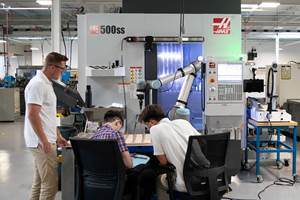Machine-Tending Robot Hits on Three Automation Trends
A new robotic loading system features a collaborative design, intuitive programming and the ability to be quickly redeployed to other turning centers.
Share





Current trends in machine-tending robot technology include collaborative robotics, in which a human can safely work near a robot without conventional fencing; easier deployment of robots to different machine tools when necessary; and simplified programming.
The Robo2Go machine-tending system from DMG MORI Systems leverages technologies that address each of these trends. It is particularly well-suited for shops that run a variety of different jobs, but would like to reap the benefits of unattended or lights-out machining on its DMG MORI turning centers that feature the company’s CELOS control.
Jeff Wallace, DMG MORI USA general manager—national engineering, says this system was developed for job shops that are new to robotic machine tending, which is why it was designed with an intuitive programming interface, meaning no dedicated robot programmer is required, and can be easily moved to and set up on various machines as necessary. (This is demonstrated in the video below.)
Hardware-wise, there are three primary system components: robot, part-loading module and safety scanning sensor. The six-axis robot is available in payload capacities of 22, 44 or 77 pounds (including workpiece and end-effector/grippers). Mr. Wallace says it can be delivered with end-effectors designed by DMG MORI, although some shops may choose to make their own end-effectors or have a third party produce them.
The robot accesses workpiece blanks from and delivers completed components to the system’s part-loading module. This module is topped with a tray that shops can machine from thin plate to best match the size, shape and number of blanks for a given job. The loading module features green and red indicators to serve as visual cues to show if all the parts in a given row is or isn’t completed. Mr. Wallace says it’s possible to program the robot to automatically flip the indicator once a row is completed.
To enable safe operation with humans working nearby, an infrared scanning sensor at the base of the unit is used to detect when someone approaches the robot. Users set up outer and inner safety zones for each machine the Robo2Go tends. Robot motion slows when someone enters the outer zone and resumes its normal speed when the person exits that zone. Robot motion stops when someone enters the inner zone closer to the robot, and resumes once an operator answers the prompt in the CELOS control to confirm that the work area is clear.
The Robo2Go can be moved from one machine to another using a fork truck. During setup, three template plates are positioned on the floor in front of the machine to initially locate the unit. The unit’s mounting pads are locked into position on those plates. An operator then “teaches” the robot so that its position relative to the machine is known. This is done by touching off a few machine datum points, such as the face of the spindle or chuck. The unit and machine communicate via the Profibus and Ethernet protocols.
Robot programming is performed at the machine’s tablet-like CELOS control using the Robo2Go app. The operator simply enters the dimensions of the workpiece, chuck and end effector, and then selects the proper workpiece tray configuration. Skeleton programs can also be created and saved to be quickly modified for new jobs.
Related Content
CNC Machine Shop Honored for Automation, Machine Monitoring
From cobots to machine monitoring, this Top Shop honoree shows that machining technology is about more than the machine tool.
Read MoreStuder's Automation, Entry-Level Solutions Take Center Stage
At its 2024 Music Motion Meeting, Studer AG showed off its entry-level line of grinding machines, as well as its newest universal loading system.
Read MoreWhich Approach to Automation Fits Your CNC Machine Tool?
Choosing the right automation to pair with a CNC machine tool cell means weighing various factors, as this fabrication business has learned well.
Read More3 Ways Artificial Intelligence Will Revolutionize Machine Shops
AI will become a tool to increase productivity in the same way that robotics has.
Read MoreRead Next
How I Made It: Dennis Rymanowski
Dennis Rymanowski has worked at NSH USA for 60 years, with his passion for manufacturing living alongside his passion for his family’s polka band.
Read MoreA New Frontier in Surface Finish Control
What if your machine tool could measure surface roughness as it cuts? This article explores how in-process metrology is advancing from concept to reality, enabling real-time feedback, immediate detection of anomalies and new levels of control over surface quality. Discover the technologies making this possible.
Read More





















